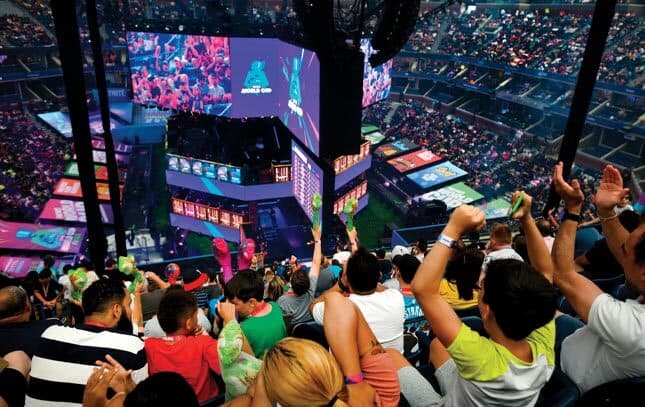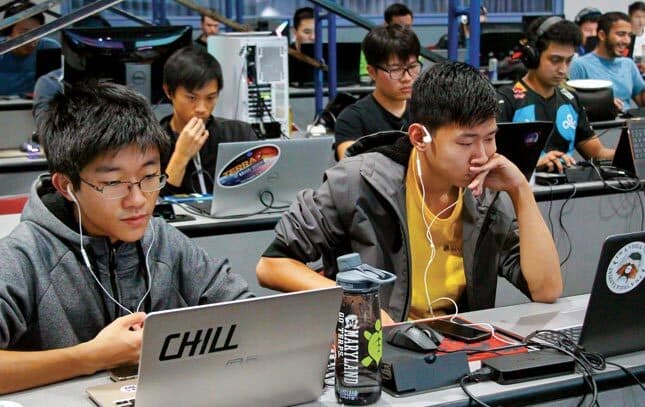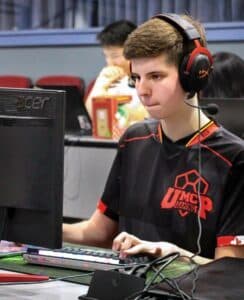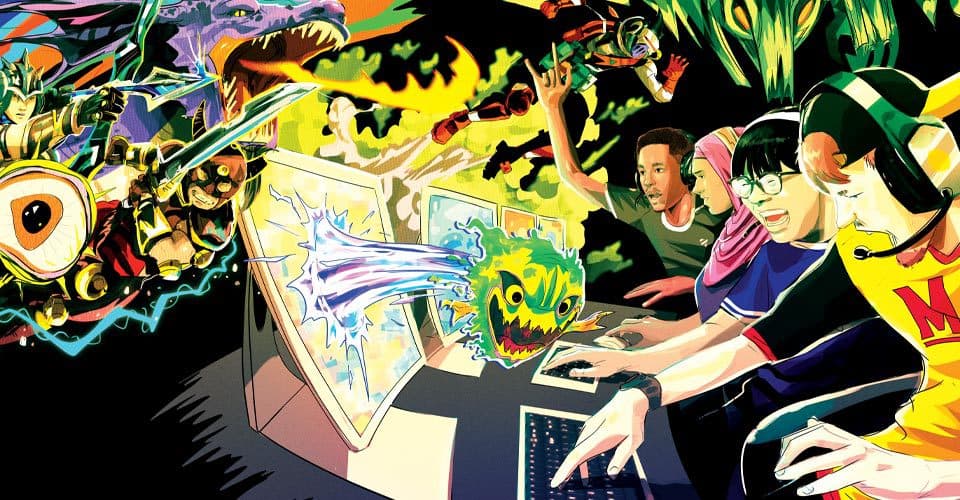Pressing Play
Esports Have Become an International Phenomenon. With Terps Already Competing at the Highest Levels, UMD Powers Up Support for Gamers.
By Liam Farrell | Illustration by RYAN INZANABRENDAN HEGARTY GRASPED EARLY in his first semester at the University of Maryland that the lectures, papers and tests of college life weren’t squaring with his constant urge to slip away to an exotic island where he could practice skydiving, bunker construction and cold-blooded sniping of his enemies.
A $30 million prize pool up for grabs didn’t hurt, either.
So in a Fall 2018 departure possible only in the digital age, he temporarily traded in his student ID for a chance to secure a spot in the lucrative championship of a sport that requires those survival skills—albeit only in a world made up of electrons and transistors.
“I figured I should just focus on one,” says Hegarty ’23. “Fortnite was not gonna wait for me.”
Hegarty’s attempt to go pro in that video game, a global phenomenon created by Tim Sweeney ’93’s Epic Games, is just one point on the scoreboard showing the rise of so-called “esports” from a niche cultural curiosity to a billion-dollar industry that fills arenas, streams to millions of fans and awards huge prizes.
Esports has also leveled up at colleges and universities, graduating from student union arcades and dorm room GoldenEye 007 sessions to full-blown institutional interest. Across the country, higher education has started doling out scholarships and investing in the uniforms, hardware and building space needed to compete, like in traditional sports.
And while UMD is only beginning to dip its toes into the deep end, gaming grassroots have already grown strong in College Park with students like Hegarty. Despite falling just short in Fortnite World Cup qualification and keeping his promise to return to UMD rather than hold on to a full-time pursuit of esports, he hasn’t disconnected his keyboard yet: So far, Hegarty has earned about $35,000 in cash prizes and scholarships from his gaming exploits.
“I stuck to my word,” he says. “I still made a pretty good amount of money.”
COMPETITION ITSELF has always been part of video games, be it chasing the high score on Centipede at the local pizza parlor or the well-documented quest for the world record on Donkey Kong.
The first known tournament took place in 1972 at Stanford University’s Artificial Intelligence Laboratory. The 20 or so players there squared off in Spacewar!, pounding buttons to pilot triangle spaceships and fire dot missiles at each other. The last player standing amid the pixelated debris took home the grand prize: a year’s subscription to Rolling Stone magazine.
The advent of one-on-one fighting arcade games like Street Fighter 2 and Mortal Kombat supercharged the scene in the 1990s before advances in console, computing and internet technology turned multiplayer gaming competitions into a genuine international powerhouse. By 2017, the “Bird’s Nest” stadium in Beijing, built for the Summer Olympics, hosted the League of Legends World Championship with as much flair as any other sporting event, opening the final rounds with musical acts, choreographed dancers and even an augmented-reality dragon swooping through the venue before stone-faced competitors in matching corporate-sponsored outfits squared off for millions of dollars.
The COVID-19 pandemic, forcing the cancellation of in-person activities worldwide, was a ready-made pivot point for esports; its audience grew nearly 10% last year to 435.9 million people, according to Newzoo, a gaming analytics firm that has projected a further 9% growth in 2021. The opportunity to fill the suddenly empty hours didn’t go unnoticed by traditional sports media, either; ESPN aired a tournament of 16 NBA players taking on each other in NBA 2K20, and FOX Sports even showed NASCAR drivers competing in virtual races.
Overall, esports is capitalizing on younger millennial and Generation Z consumers whose childhoods were filled with these types of games, says Hank Boyd, clinical professor in the Robert H. Smith School of Business’ marketing department. Competition organizers, he says, have also had the foresight to combine gaming with other forms of entertainment to hold attention spans—for example, a Lil Nas X performance hosted last November by the Roblox platform garnered 33 million views and, a few months earlier, several Fortnite shows by rapper Travis Scott collected 45.8 million views.
In other words, you can feast on not only a gaming version of the Super Bowl, but also its halftime show.
“It’s a game, but it’s really more than a game,” Boyd says. “This is something that’s defining a generation.”

Esports fans cheer during the finals of the 2019 Fortnite World Cup held at New York City’s Arthur Ashe Stadium. While once a niche attraction, these competitions can now draw tens of thousands for in-person contests. (Photo by Johannes Eisele/AFP via Getty Images)
TRADITIONALISTS IN THE ATHLETIC world have worn trenches in their foreheads from furrowed brows over all this, unable to move beyond the pesky “sports” embedded in “esports.”
For someone used to viewing competitive actions that have no virtual intermediary—baseball players swinging a real bat that hits a real ball, basketball players jumping and slamming a real ball through a real hoop—the visual disconnect between a stationary row of people clacking computer controls and Jumbotrons streaked with whirling warriors can be jarring. Then there’s navigating the sharp learning curve in understanding the multicolored chaos splashing across those screens, particularly in a game such as League of Legends, wherein teams of other-worldly “champions” with different skills and abilities battle each other to destroy the glowing, crystal “nexus” inside the enemy’s base.
The dialogue on the issue can range from the considered to the stereotyped. In one 2013 roundtable discussion from HBO’s “Real Sports with Bryant Gumbel,” some panelists advocated for a distinction between “sports,” which necessitate substantial physical exertion, and “games,” which require competitive skills but lack any strenuous athletic demands. Other commentators were far more dismissive, however, wondering “How many of those people also go to ‘Star Trek’ conventions?” and the well-known sportswriter Frank Deford labeling esports viewers as “crazier than the ones playing.”
But from a spectacle standpoint, it’s undeniable that sports and esports do share a great deal. Both genres have studio announcers and postgame interviews, ecstatic winners and heartbroken losers, cocky superstars and pantheon achievements (check out “EVO Moment #37,” for one example). Scientifically, there is a relationship as well—a 2016 study from the German Sports University found esports players surpass table tennis in terms of hand-eye coordination demands, produce stress-induced cortisol levels similar to racecar drivers and have heart rates approaching marathon runners’.
So it’s not a surprise that someone like Will Vickers ’21 wound up playing a role in the UMD gaming community. A varsity athlete at Bishop McNamara High School in Forestville, Md., who played baseball at the College of Southern Maryland before transferring to UMD in 2019, Vickers found a new outlet in College Park for those same competitive instincts. This time, however, he traded in a bat, ball and glove for the futuristic weapons, electric charges and bomb-hunting of Valorant.
“I still like traditional sports,” says Vickers. “I put esports on the same level as them.”
He was also social media manager for the UMCP Gaming Club, a student-born and -run group that boasts more than 1,800 members and 50 competitors who take part in tournaments as Terp teams.
“Gaming is not taboo,” Vickers says. “People are like,‘You play games? What do you play?’”
GIVEN THE DEMOGRAPHICS—a 2018 poll found that 58% of Americans ages 14 to 21 had played video games competitively—higher education was destined to become a fertile field for esports.
Smaller schools were some of the earliest to jump on the bandwagon for various institutional and cultural reasons, seeing them as a way to bolster everything from student enrollment to campus pride. In 2014, Robert Morris University Illinois became the first college to promote esports to a varsity competition, launching a League of Legends team with up to 50% tuition and 50% room-and-board scholarships for eligible gamers. Since then, more than 170 schools with varsity esports programs have joined together in the National Association of Collegiate Esports, representing more than 5,000 student-athletes and $16 million in scholarships and aid.
Within a 250-mile radius of College Park, however, the vast majority of these varsity programs are at schools that otherwise compete in Division III, and none has football in the so-called Power Five conferences, the general marker of top-tier collegiate athletics programs. While it’s clear how select student gamers would benefit from the uniforms, equipment, facilities and increased prestige that would come with a varsity designation, it’s less obvious at this nascent stage for a university like UMD, which has legions of fans devoted to traditional athletics programs, an already-large base of STEM students and plenty of existing opportunities for Terps to compete at tournaments.
UMCP Gaming, for example, has put teams into the American Video Game League, North American Competitive Collegiate Series, Collegiate Open League and other competitions for thousands of dollars in prizes. In the Collegiate Star League, UMD teams were collectively ranked fourth at the end of last year, behind only the University of Ottawa, the University of California-Berkeley and Northeastern University.
In December, the trio of Hegarty, Erik “Mars” Kelemen ’22 and Mazin “Se7enn” Karjikar ’24 split $15,000 in tuition prize money by taking first place in the PlayVS collegiate Fortnite league affiliated with Epic Games. In March, Hegarty and Kelemen divvied up another $1,000 from topping the AVGL Collegiate Champions League.
So far, the institutional footprint at UMD has been limited to intramural, one-on-one competitions in franchises like NBA2K, Madden football and FIFA Soccer, in addition to Fortnite and team leagues for Rocket League. But new opportunities are coming—University Recreation and Wellness (RecWell) is hiring its first esports coordinator, for example, to give the same administrative support around facilities, travel and fundraising that club sports like crew, rugby and ultimate Frisbee already enjoy. Other ideas under consideration include repurposing underused racquetball courts in the Eppley Recreation Center for club esports teams and the general student body, or putting aside space in The Diner after a new north campus dining hall opens.
UMD is also analyzing what peer institutions such as Ohio State, Rutgers and Penn State have furnished for esports, and is identifying approximate space and technology needs, says Jay Gilchrist, director of RecWell. The pandemic, however, short-circuited early discussions, and an ensuing budget crunch plus an ongoing premium on available campus space will remain considerations.
“(Gamers) get an incredible sense of pride representing the university. That’s one of the things any university is looking for in the long run,” Gilchrist says. “It’s just going to have to be an organically grown thing.”
Hegarty, for his part, thinks UMD—and college esports in general—are a sleeping giant. Now the president of UMCP Gaming and a campus ambassador for the Alienware brand of gaming products from Dell, he believes it’s only a matter of time before warring leagues consolidate and push in a unified direction.
“In a few years it will be that way,” he says. “Everyone is fighting for that market share.”

Terp gamers, including Matthew Eye ’22 (below), come together at the 2019 Harvest Moon LAN (local area network) event in the Computer Science Instructional Center hosted by UMCP Gaming. The group is a community of more than 1,800 members and dozens of high-level competitors.
WHILE A DECADE of glowing headlines may suggest unending progress toward esports domination, some skeptics believe it has already reached its ceiling.
They question whether event viewership numbers have been artificially inflated by seeding live video streams into unrelated websites, and if the dominance of publishers—whose ultimate goal is to sell games and consoles to players rather than attract casual viewers—will limit esports competitions to hardcore gamers instead of appealing to the general public. (The NFL, for example, does not ultimately measure its success by the number of footballs sold.)
And despite its digital lifeblood, esports has faced its share of COVID-19 challenges as well. ESPN eliminated its entire staff of esports writers last year as part of widespread company layoffs, judging the topic still too niche-oriented for the investment and not requiring the attention of a dedicated team of reporters. Organizers for the Dota 2 championships, one of the industry’s most lucrative with a $40 million prize pool, had to scramble in summer 2021 for an alternate location after the Swedish government wouldn’t classify it as an “elite sporting event” and grant visas for traveling participants.
Inside the esports scene itself, some high-profile stars have also burned out on competing professionally and switched to streaming content on platforms such as Twitch. Enver Rahman ’20 is making a go of that latter approach, and the computer science graduate from Rockville, Md., has nearly 8,000 followers for his instructional and coaching streams on League of Legends.
Rahman, who works as a software engineer for Infosys, likens the game to “fast-paced chess,” and found that his intellectual grasp of game strategy outpaced his physical reflexes for controlling the characters. He’s keeping an eye out for potential coaching positions in esports and hopes to one day be there full-time.
“There’s two teams going at it. It’s the exact same concept (as traditional sports), just virtual,” he says. “I love helping people become better players.”

The size of that player pool likely depends on fixing some notorious systemic cultural issues. Black players often see racial slurs in live comment sections while competing, and women can face debilitating hostility. “Gamergate,” an internet controversy that originated in 2014 with innuendos about relationships between developers and journalists, metastasized across social media sites into a full-blown culture war of accusations, harassment, and rape and death threats slung at female gamers attempting to diversify the community and its content.
Some issues have occurred in the UMCP Gaming chats on the social network site Discord, says Adeline Wu ’23, vice president of competitive for the group who uses they and them pronouns. While the tenor of the dialogue has improved over time, Wu says slurs and demeaning insults can still pop up, and they have even gotten some criticism for including preferred pronouns in their officer bio.
“When you play video games often, especially competitive ones, people will let the competition show a harsher side of themselves,” they say.
But the collegial environment in College Park has generally lent itself to more friendly and accepting interactions between gamers than in the wider Internet, says Jane Mendez ’24, an officer in UMCP Gaming who coordinates games in Team Fortress 2, a multiplayer first-person shooter title. She believes more consistent opportunities, promotion and support for female esports players at gaming’s top levels would open doors for younger competitors.
“I think we’ll see more female teams and leagues specifically for girls,” Mendez says. “It can be intimidating going on a team of all guys.”
However the larger trends evolve, Vickers is confident that UMD—with its large base of students, successful gamers and vibrant science, technology, engineering and math programs—is positioned to be a force in an industry still finding it way.
“It’s in its infancy stage,” he says. “Give it five to 10 years.” TERP
0 Comments
Leave a Reply
* indicates a required field

